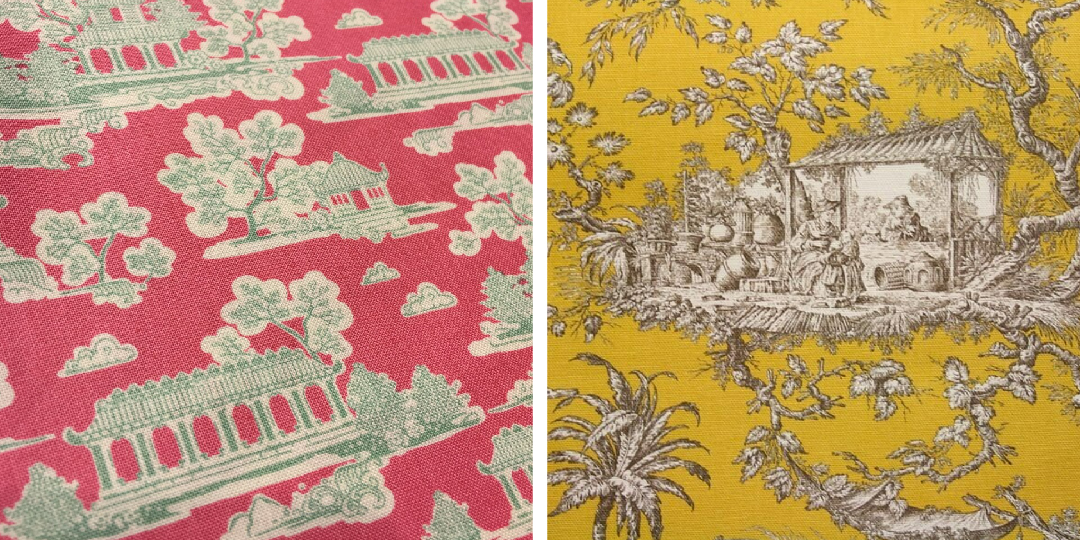Historic Patterns: Toile de Jouy
Apr 28, 2023
Did you know, Toile de Jouy has become one of my specialties when it comes to creating custom made patterns for clients? Being a 250 year old pattern style hasn’t in any way made it undated, on the contrary. I think it’s a very contemporary style, with lots of evocative qualities of charm and soul - something we obviously need a lot of today.
I believe people need beautiful and inspiring surroundings to thrive and be happy. And what style is more perfect for that than the Toile de Jouy?

Popular products with Toile de Jouy patterns. Designs by ©Bärbel Dressler.

Toile de Jouy is that romantic pattern style with detailed and illustrative scenes, typically on an off-white background that you often see on wallpaper and home textiles. It was developed in France in the 1770s and has been a highly popular pattern ever since and is associated with high end products and brands.
In this article you’ll get an introduction to the history of the Toile de Jouy pattern style and what characterizes it. I will also share my step-by-step process for designing a complex pattern like this.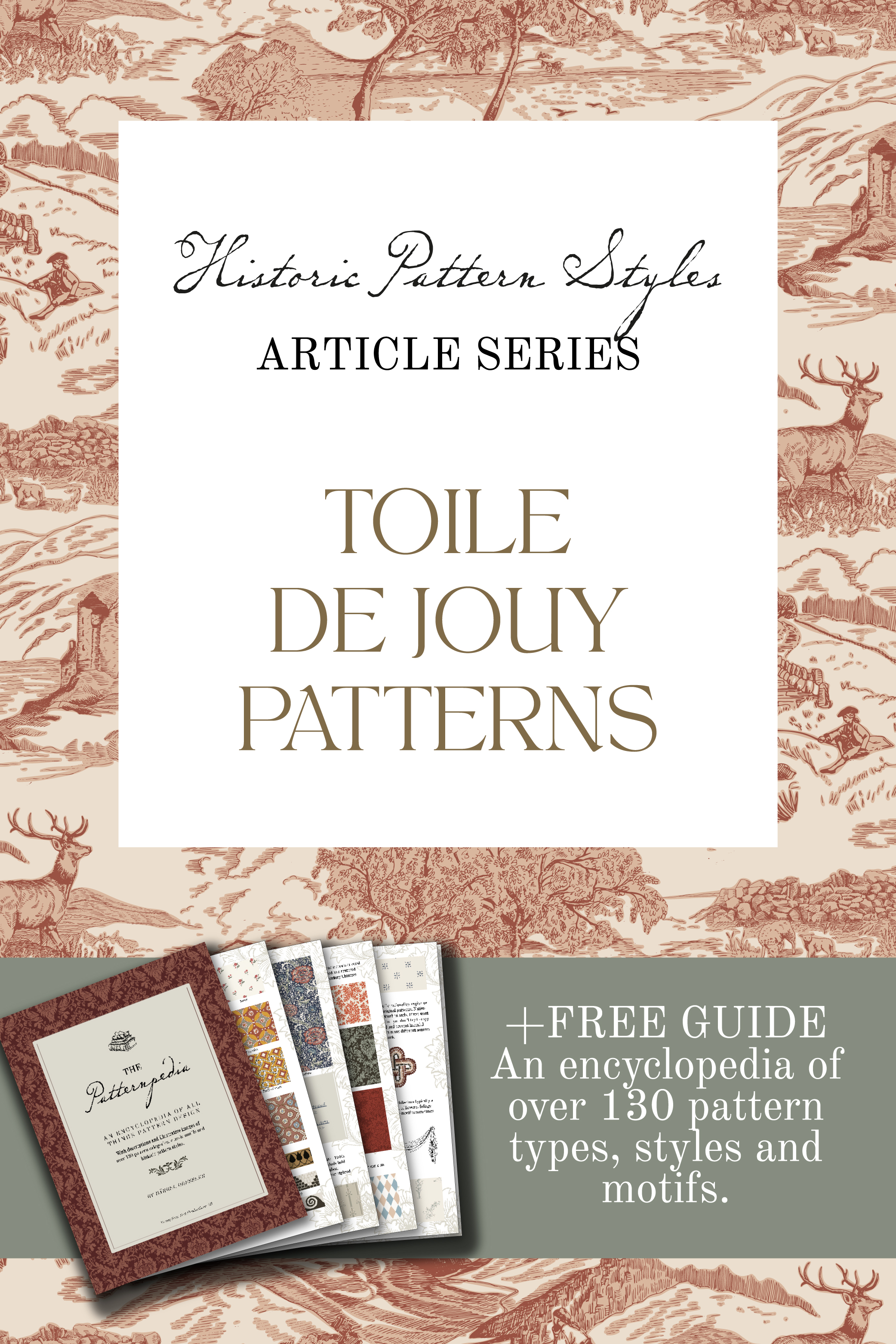
THE NAME
The term ”Toile de Jouy” literally means ”cloth from Jouy” and Jouy refers to the small town outside of Paris called Jouy en Josas. This place had one of the biggest and most famous producers of printed cottons during the 18th and 19th century - the Manufacture Oberkampf. Their prominent position and the number of Toile de Jouy fabrics produced there made this pattern style forever known as Toile de Jouy. With that said, there were many other fabric manufacturers who printed their own versions.
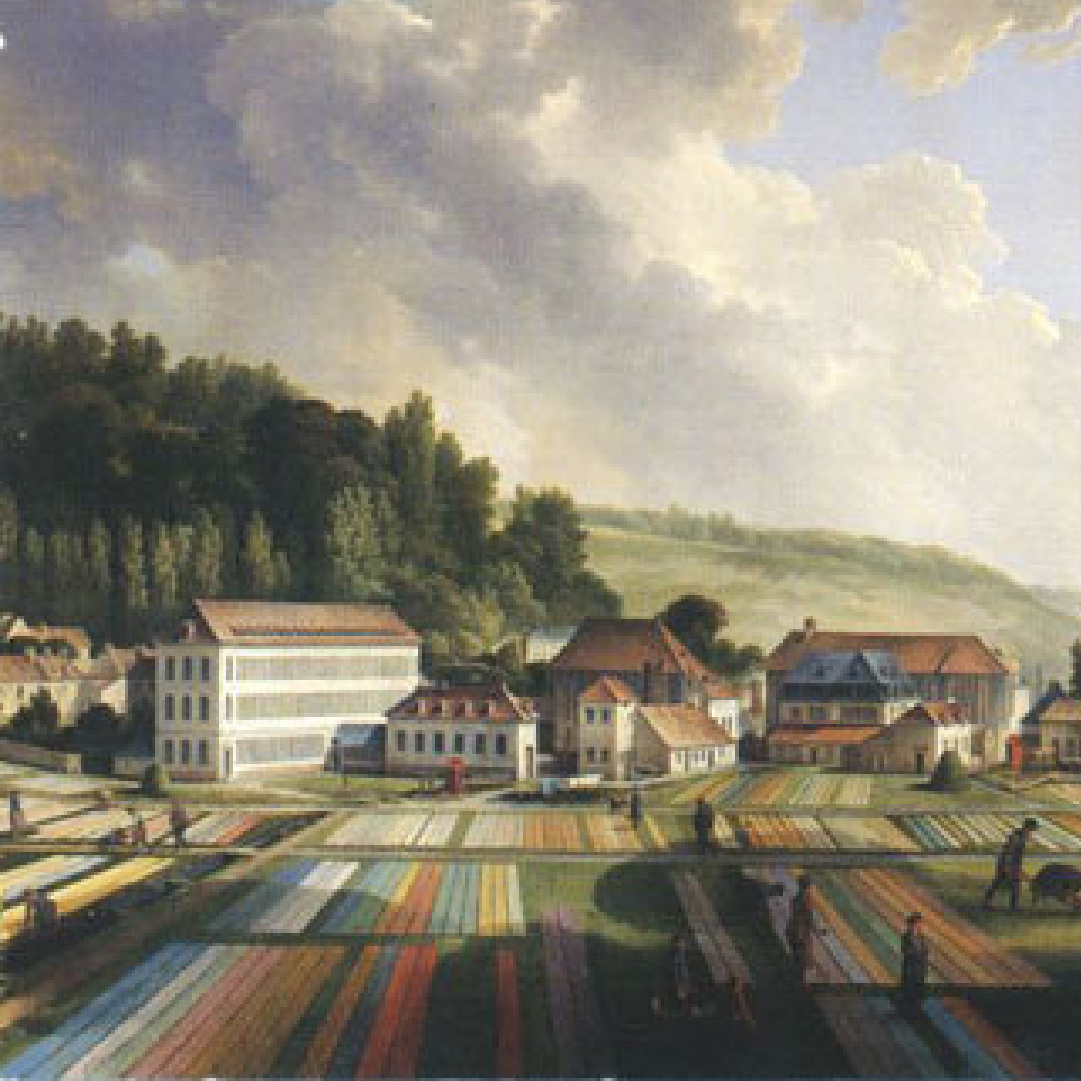
The Manufacture Oberkampf in Jouy en Josas. You can see long stripes of fabric laid out on the grounds to dry in the sun.
THE HISTORY OF TOILE DE JOUY
The history behind the Toile de Jouy style is as with any pattern style tightly connected with the materials and techniques.
THE MATERIAL
The ”toile” - was cotton, a material that became highly popular during the 17th century thanks to the import of the Indian printed cottons - or chintzes as they were also called.
Printed cotton was first introduced to France and Europe in the late 16th century. During this time India was the largest producer of cotton textiles in the world. They had developed sophisticated processes and techniques for printing and painting fabrics that resulted in cloth that had beautifully detailed and brightly colorful patterns - and with colors that didn’t fade.
Cotton textiles were also much more lightweight and easy to wash unlike the silks and wool that was mostly used in Europe up till then. These were the reasons why the printed cottons became such a wild success. And It was used for everything - clothing, wall coverings, curtains, upholstery and bedclothes.

Indian printed cottons, or “Chintz” with bright dye-fast colors.
The secrets of the Indian process for printing these dye-fast colors using fixating mordants were revealed to European manufactures first around 1760, which became the start of a new golden era for the French cotton manufacturers, among them Manufacture Oberkampf in Jouy.

THE PRINTING TECHNIQUE
The Indian manufacturers had been using block printing which is an old printing technique that had also been used in Europe since the 14th century, but hadn’t evolved much since then.
But now that the manufacturers required the new Indian dyeing techniques and processes using mordants to help fixate the colors to the cloth, the European manufacturers started to develop the techniques even further and use them in new ways.
For example the use of plate printing. This was a new printing technique that had been developed in Ireland and used there and in England for a number of years already, but was now introduced to France as well.
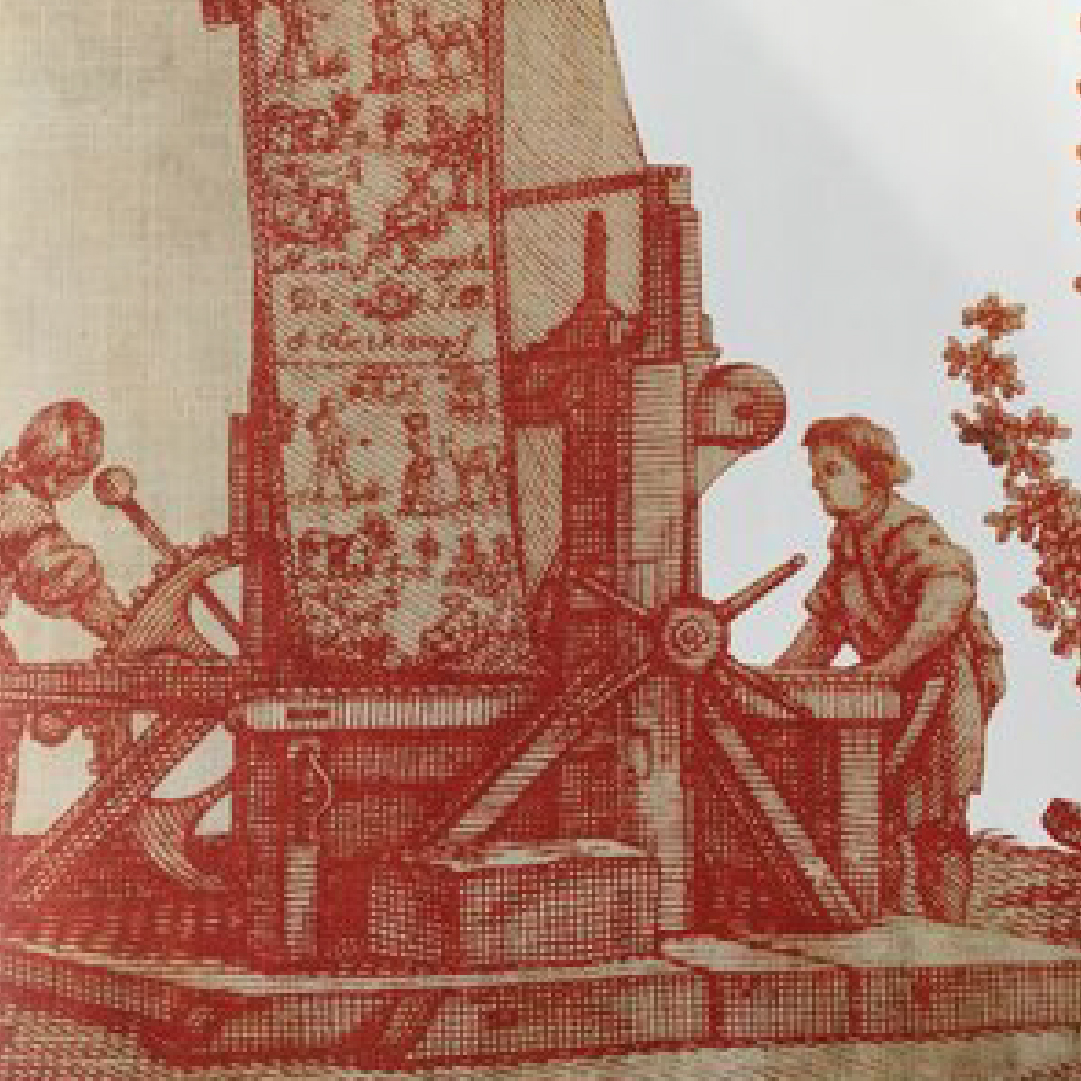
Scene from a Toile de Jouy pattern depicting the process of copper plate printing.
This new technique influenced the development of more detailed and delicate motifs and a new type of pattern that showed figures and landscapes. The manufacture Oberkampf was one of the first to start using plate printing in 1770, and quickly commissioned the best artists to design this type of new popular patterns. One of them was a painter called Jean-Baptiste Huet and he was probably the one who shaped the genre the most.

TRENDS AND INFLUENCES
The style that influenced the Toile de Jouy patterns was mainly Rococo, with idyllic and romantic motifs, pastoral scenes of parties having a picnic, couples courting, of the countryside and rural life and landscapes.

Left Image:
Centre Image:
Right Image: "a la campagne" Toil-de-Jouy revived by Casal as part of their Patrimoine collection.
After the French revolution another style called the neoclassicism influenced the patterns instead, abandoning the romantic celebration of the pastoral countryside and became more strict, with influences from ancient Rome and Greece instead.
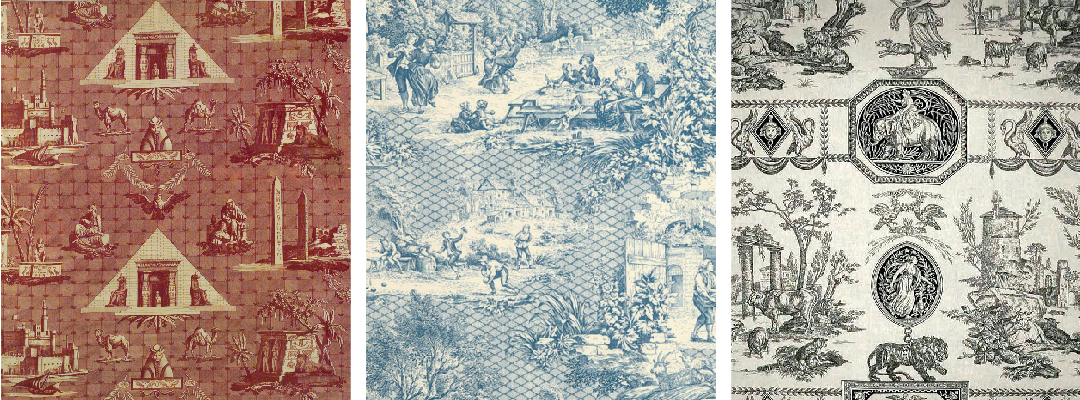
Left image: "Les monuments d'Égypte" Manufacture: Oberkampf Manufactory French Designer Jean-Baptiste Huet I French After an illustration by Louis François Cassas French ca. 1808
Diane chasseresse" Designed by Jean-Baptiste Huet I French Manufacture Oberkampf Manufactory 1805
The designers often used well known rococo paintings as their source materials and inspiration for their designs. They copied freely from them and used as motifs that would appeal to the popular trends.

WANT TO LEARN ABOUT HISTORICAL AND CLASSICAL PATTERN STYLES, TYPES AND MOTIFS?

CHARACTERISTICS OF THE TOILE DE JOUY PATTERN STYLE
So let’s take a look at some toile patterns and what characterizes them.
THEMES
Toile patterns are narrative, which means they tell stories, they’re centered around a specific event or theme influenced by the current trends and events - like the first balloon flight, or a royal visit.
Love was a very popular theme, depicting couples courting and cuddling.
Rural life and the countryside was common settings, showing motifs of everything from the farmers daily life to celebrations of traditions and other festivities.
Other themes were well known or popular fables and poems. Stories from the greek mythology and the Bible were also commonly used sources of inspiration for the designers.
In the era of enlightenment, people, animals and plants from exotic places like Africa and China was frequently used as inspiration, as well as archeology, especially in ancient Egypt and Greece.

Images: The first balloon flight | Love, love, love | The story of Robinson Crusoe | Chinese exoticism

MOTIFS
First of all, a typical Toile de Jouy pattern motifs are made into scenes with some recurring components that can be helpful to know of when you design a Toile de Jouy inspired pattern of your own.
Trees and foliage, grass and other shrubbery were important motif elements to build up the landscape or countryside settings in the scenes. The landscapes are often crowned with fluffy clouds.
Another common motif element is buildings, it could be a small cottage, a shed, a stone wall or bridge, or - something that seemed to be very popular and considered romantic - the ruin.
And not to forget - figurative motif elements, of people and animals.
Last but not least we have flowers, branches, leaves, birds and insects. Flowers and foliage frequently used were Roses, Vines, Peonies, Pansies and Carnations.

LAYOUT
Usually the number of motifs or scenes were between four or six. They could be arranged tightly in a dense layout with little space in between the motifs, or loosely, sparse and floating across the fabric.
The motifs, or scenes are always arranged in a half drop layout to create a nice flow.
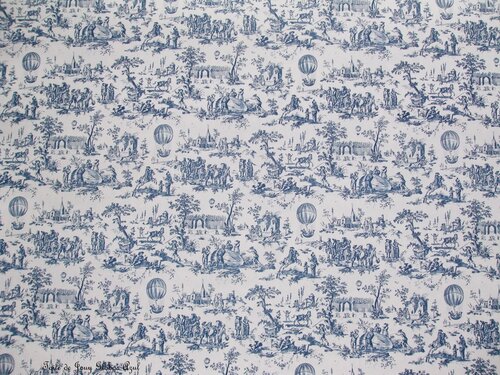
COLOR
One of the limitations of the plate printing technique was color - as it was best suited for monochrome colors and the traditional toile had one color printed in relief on a white or off-white background and the most frequently used colors were either black, grey, brown, red, purple or blue.
But there did exist toiles with more colors, at least two, with the background in one color and the scenes and motifs in another. Underneath the scenes the background was uncolored which created a decorative contrast.
